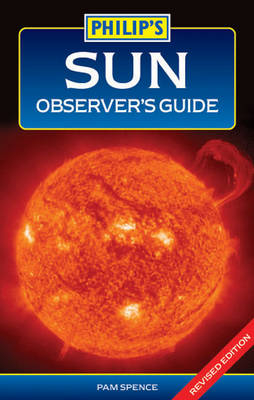
Philip's Sun Observer's Guide
Seiten
2013
|
Revised ed.
Philip's (Verlag)
978-1-84907-068-3 (ISBN)
Philip's (Verlag)
978-1-84907-068-3 (ISBN)
- Titel wird leider nicht erscheinen
- Artikel merken
A guide to observing our 'home' star. It illustrates and explains the structure of the Sun, so that the observer knows what to look for and why certain features can be seen. It describes how to observe in white light (the visible range of the electromagnetic spectrum), with information on what to look for and how to record the observations.
"Philip's Sun Observer's Guide" is a practical guide to observing our 'home' star. There is huge fascination in observing the Sun, and this book explains how straightforward - and safe - it can be to do so. Contrary to popular opinion, expensive equipment is not required, and the necessary safety procedures are easy to follow. The guide follows a logical sequence. First, the structure of the Sun is explained and illustrated, so that the observer knows what to look for and why certain features can be seen; then the author details the equipment required and the methods that can be employed. The author next describes how to observe in white light (the visible range of the electromagnetic spectrum), with information on what to look for and how to record the observations. The following chapter deals with non-white light observing, using instruments such as spectrohelioscopes and various types of filter. One of the most widely observed solar phenomena is the solar eclipse. This book has an entire chapter dedicated to eclipses, explaining why they occur, what can be seen and how to observe them safely. Dates of forthcoming eclipses are provided.
Most astronomers are keen to record their observations, and photography is one of the ways in which this can be done. The author discusses the equipment required and the various methods of photographing the Sun. Examples show what can be achieved. "Philip's Sun Observer's Guide" concludes with a chapter on professional solar astronomy. Although the book is aimed at amateur astronomers, it is fascinating to read about the research that is currently being undertaken, and to discover the value placed by professional astronomers on observations made by amateurs. Spectacular images have been taken by solar spacecraft, and many are displayed here. "Philip's Sun Observer's Guide" is a highly informative and practical introduction to a fascinating hobby.
"Philip's Sun Observer's Guide" is a practical guide to observing our 'home' star. There is huge fascination in observing the Sun, and this book explains how straightforward - and safe - it can be to do so. Contrary to popular opinion, expensive equipment is not required, and the necessary safety procedures are easy to follow. The guide follows a logical sequence. First, the structure of the Sun is explained and illustrated, so that the observer knows what to look for and why certain features can be seen; then the author details the equipment required and the methods that can be employed. The author next describes how to observe in white light (the visible range of the electromagnetic spectrum), with information on what to look for and how to record the observations. The following chapter deals with non-white light observing, using instruments such as spectrohelioscopes and various types of filter. One of the most widely observed solar phenomena is the solar eclipse. This book has an entire chapter dedicated to eclipses, explaining why they occur, what can be seen and how to observe them safely. Dates of forthcoming eclipses are provided.
Most astronomers are keen to record their observations, and photography is one of the ways in which this can be done. The author discusses the equipment required and the various methods of photographing the Sun. Examples show what can be achieved. "Philip's Sun Observer's Guide" concludes with a chapter on professional solar astronomy. Although the book is aimed at amateur astronomers, it is fascinating to read about the research that is currently being undertaken, and to discover the value placed by professional astronomers on observations made by amateurs. Spectacular images have been taken by solar spacecraft, and many are displayed here. "Philip's Sun Observer's Guide" is a highly informative and practical introduction to a fascinating hobby.
Pam Spence trained as an astronomer, and observed the Sun both as an amateur and professional. She was assistant to the solar section director of the British Astronomical Association. At University College London, she worked on solar data gathered from the Yohkoh satellite.
| Erscheint lt. Verlag | 7.10.2013 |
|---|---|
| Reihe/Serie | Philip's Astronomy |
| Zusatzinfo | Illustrations (chiefly col.), col. maps |
| Verlagsort | London |
| Sprache | englisch |
| Maße | 126 x 198 mm |
| Themenwelt | Sachbuch/Ratgeber ► Natur / Technik ► Weltraum / Astronomie |
| ISBN-10 | 1-84907-068-7 / 1849070687 |
| ISBN-13 | 978-1-84907-068-3 / 9781849070683 |
| Zustand | Neuware |
| Haben Sie eine Frage zum Produkt? |
Mehr entdecken
aus dem Bereich
aus dem Bereich
Perspektiven auf die Menschheit
Buch | Hardcover (2024)
Klett-Cotta (Verlag)
25,00 €
auf der Suche nach neuen Planeten und außerirdischem Leben
Buch | Hardcover (2024)
Droemer (Verlag)
24,00 €


